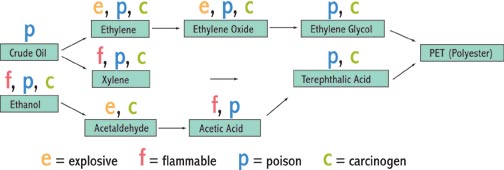Liv' ving in a Material World - wants to kill yo' ou!

It's a polyester world. Wearable petroleum in shimmery high fashion formaldehyde-finished perfection, and assassination method of choice for world leaders.
Did you see the Secretary of State gift the Russian oligarch's wife a beautiful Versace dress? It will kill her in 10 to 20 years, and she won't see it coming.
The process in a Flash
A refined and carcinogenic petroleum gas called ethane is flash heated to nearly 1,500 Fahrenheit (800 Celsius) where ethane becomes ethylene. Antimony, a heavy metal catalyst is added, essentially turning ethylene into goo. If you spin the goo, it turns into fiber that can be woven into cute Versace dresses, and most of the clothes in our closet. Antimony is a carcinogen which deeply offends the heart, lungs, liver and skin.

- The Danish Environmental Protection Agency found that 10 percent of antimony from polyester seeps into the skin when we sweat.
- Polyester emits phytoestrogens, an endocrine disrupter. Also known as angry gangster mime artists effectively mimicking hormones. The turf wars they initiate often leads to cancer in their 'hood.
- Cancer cells multiply rapidly in polyester test tubes compared to glass tubes.
I want to assure you, I'm no polyester bigot. There are plenty of other materials so nasty, you no longer need to ask the seemingly unanswerable question to random inanimate objects: Is it just me, or is everybody getting cancer these days? Look at these chemical beauties:
Rayon
 The Rayon starts as a beautiful image, like a young princess walking through the forest with singing birds carrying picnic blankets. Rayon is made out of recycled wood pulp or bamboo cellulose. That's the princess forest moment.
The Rayon starts as a beautiful image, like a young princess walking through the forest with singing birds carrying picnic blankets. Rayon is made out of recycled wood pulp or bamboo cellulose. That's the princess forest moment.
But then it turns nasty. In order to convert the pulp into beautiful rayon cloth, one must pour carbon disulphide, sulfuric acid, ammonia, acetone and caustic soda onto it.
Rayon gives off carbon disulphide while you walk, talk with your friends at coffee shops, and otherwise pursue your unicorn farm dreams. It's been known to cause nausea, headaches, vomiting, chest pain and insomnia, among even scarier things.
Acrylic
It’s hard to imagine anything good can come from a fiber with the name acrylic. It’s made out of a slew of toxic substances and is directly linked to breast cancer.
Nylon
 This strong and colour-loving petroleum product is responsible for making your skinny jeans and crop jackets tight and pre-shrunk. Caustic Soda, sulphuric acid and formaldehyde are used in its manufacturing. Nylon is made from benzene, a carcinogen linked to three kinds of leukemia. Carcinogenic Formaldehyde is emitted when our body heat warms the material.
This strong and colour-loving petroleum product is responsible for making your skinny jeans and crop jackets tight and pre-shrunk. Caustic Soda, sulphuric acid and formaldehyde are used in its manufacturing. Nylon is made from benzene, a carcinogen linked to three kinds of leukemia. Carcinogenic Formaldehyde is emitted when our body heat warms the material.
Unique to Nylon is that it seems unsatisfied in trying to kill us; it also emits greenhouse gases like nitrous oxide - while you're wearing it!
Wrinkle Free
That moment where you collect your dry, laundered clothes, and your wrinkle-free items go straight into the closet, saving you time to read my article.
This moment where you discover that it is formaldehyde resin and Teflon (PFCs) you have to thank, for ridding your clothes of nasty wrinkles once and for all.
Keep your appearance up and upkeep down
~ The slogan of the first formaldehyde inseminated clothing company circa 1950
Formaldehyde-laced fabrics are linked to a 30 percent increase in lung cancer, skin/lung irritation and contact dermatitis. The following words are synonyms of we've covered your clothes with formaldehyde so we can kill you:
- Anti-cling, anti-static, anti-shrink
- Waterproof
- Perspiration-proof
- Moth-proof and mildew resistant
- Chlorine resistant
Is this the Armageddon?
I've always wanted to ask that question. I tell you what it is: It is an excellent time to invest in a wardrobe made of organic materials, like hemp, bamboo, and cotton.
But Mama, which textile is worse for the environment?
Besides the carcinogenic non-biodegradable pollution that spews into the air from textile factories, darling? Natural materials require far less energy to produce than laboratory-made fabric.
|
Embodied Energy used in production of various fibers: |
|
|
energy use in MJ per KG of fiber: |
|
| hemp, organic |
2 |
| flax |
10 |
| hemp, conventional |
12 |
| cotton, organic, India |
12 |
| cotton, organic, USA |
14 |
| cotton,conventional |
55 |
| wool |
63 |
| rPET |
66 |
| Viscose |
100 |
| Polypropylene |
115 |
| Polyester |
125 |
| acrylic |
175 |
| Nylon |
250 |
* rPET is recycled polyester, popular in sport wear.
Organic cotton or bamboo might cost a little more, but what is the price of staying out of the oncology clinic? I don't like the feel of synthetic fiber. It makes my skin feel hot. The strange chemical reaction my skin has to the concoction exhaled by these clothes create a funk like nothing else.
And that, my friend, is why the 70's polyester explosion was the singular muse for the dawn of funk music. Until then, there was no sound that could remotely describe such aroma. You read it here first.
{photo credit: Versace, Guess Jeans, Zoolander}


 Yoga Leaks
Yoga Leaks